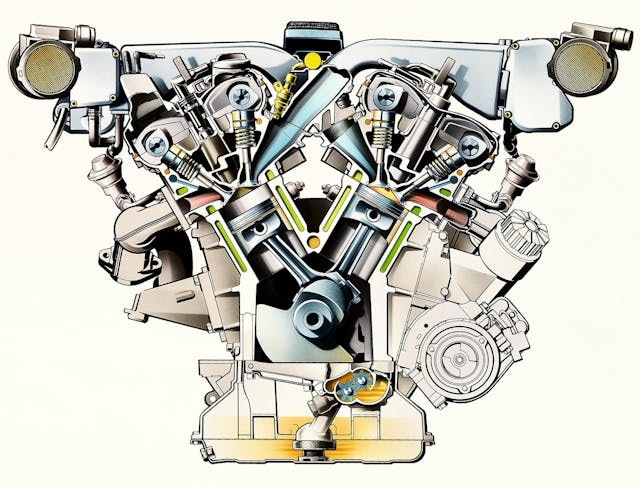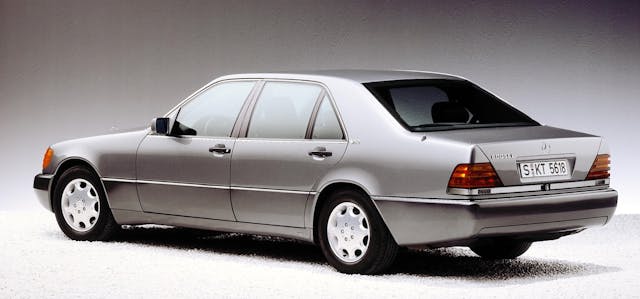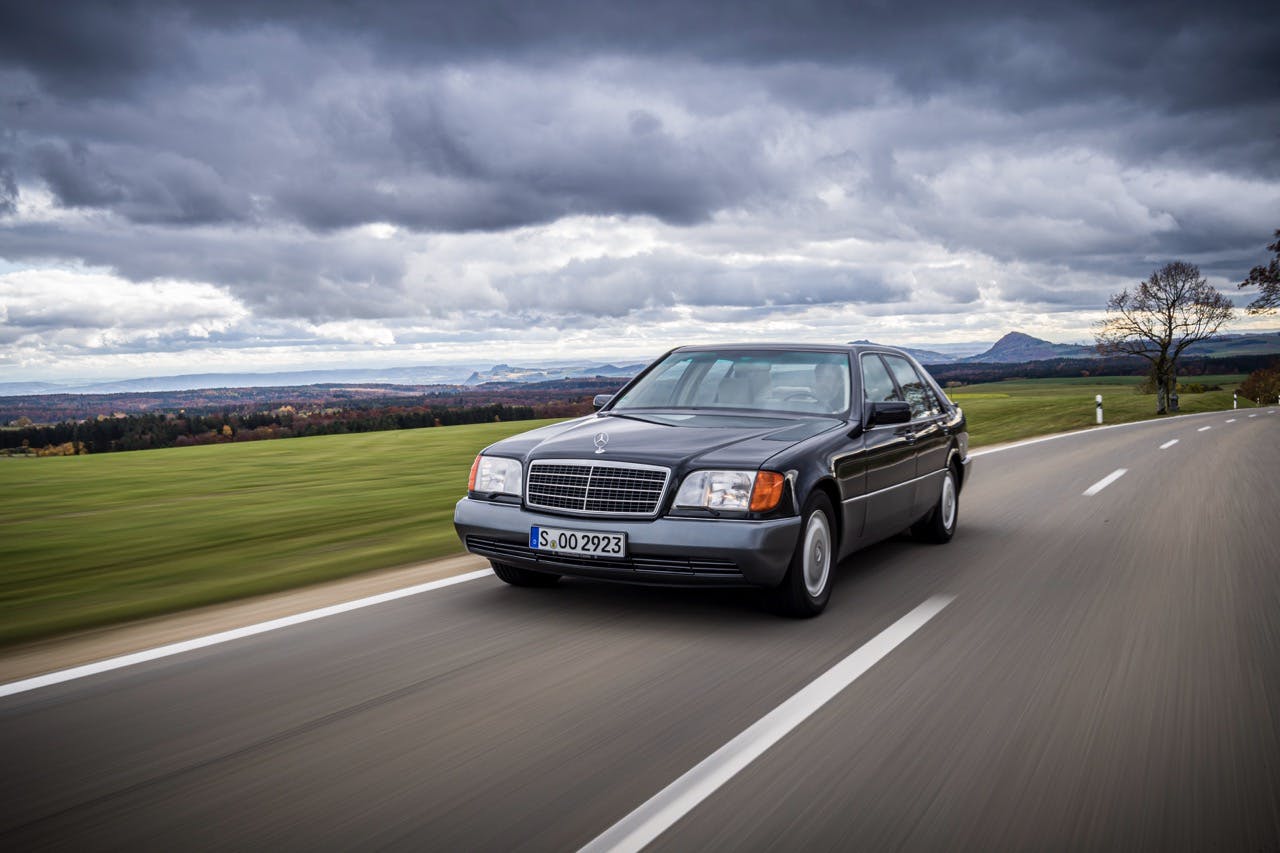Media | Articles
For All Its Foibles, Was the W140 S-Class the Last “Proper” Mercedes-Benz?
“The last properly built Mercedes-Benz, when engineers held sway over the accountants.” If you’ve ever drifted your eyes over the classifieds in search of 1980s and 1990s Mercedes metal, you’ll have seen these thoughts attached to the 190E, the R129 SL, and everything in between.
The real one has to be the W140 S-Class, for reasons we’ll come to. But mention its codename to the majority of Mercedes-Benz aficionados and you’ll receive a bemused shrug, much like the one you could almost feel its stylist, the late Bruno Sacco, eliciting as he gazed at what the C140 S-Class coupe could have been. Even 40 years since its development began, Mercedes-Benz has done little to celebrate its existence.
Perhaps it’s because for many, there’s little to celebrate. This was a car whose development was battered by fanatical engineers, corporate one-upmanship, and the onset of the Japanese into the luxury market, and it was released into a world which found its mere presence at best distasteful, at worst reckless. Even worse, the ripple effects from its development would put almighty dents in the Three-Pointed Star’s reputation.

It was all very different in 1984, when work on the W126 replacement began. At the time, the S-Class was perceived as the greatest car in the world, unless you lived in Britain. There the motoring press still sided with the home team; the long lunches that turned into evening dinners that secured the yearly ad budgets must have done much to obscure the unreliability and poor build quality of contemporary Jaguar XJs.
Despite the Mercedes-Benz comfortably outdoing the Coventry contender in almost all respects, the XJ would originally inspire the W140’s look—Sacco penned a sporty shape to take on relative luxury upstarts BMW. Then, on one day in 1987, it all started to go a bit wrong.
Marketplace
Buy and sell classics with confidence
Chief engineer Wolfgang Peter and car line manager Rudolf Hornig had descended on the styling laboratory to try out the seat layout ergonomics in a mock-up of the new cockpit. The men were of particularly Germanic dimensions, both at least 6 feet 3 inches tall. Both ended up banging their heads on the roof upon getting in.
This two seconds of mild discomfort for two generously proportioned gentlemen would have deep, long-lasting repercussions for the entire company. The buck was fitted with a removable roof, so when the dull thud was heard a panicked team began to lift it off. As they lifted it off, the two voices said in unison, “That’s great now!”
A further two centimeters would be added in height, despite howls of protest from the design team, who believed the car looked a bit like a top hat. Mercedes-Benz boss Werner Niefer sided with the engineers, and soon Sacco’s sporty vision would be forgotten. Instead, the new S-Class would have to dominate the road in Europe and North America.
Actually keeping it on the road proved to be the immediate challenge. Adding height to the roof completely flummoxed the handling, so the car was hastily made wider—the growth spurt had begun, and serious questions were being asked of the suspension.

Hornig had a solution, inspired by turn-of-the-century horse-drawn limousines, which used leather straps to suspend the passenger compartment. Hornig’s idea was to use a perimeter frame, within which the body could be mounted by a separate suspension system to the chassis. His team spent 18 months and many deutsche marks investigating this, but they ran out of time to get the technology to work; the S-Class would revert to contemporary subframes. If you’ve ever felt sick in the back of a swiftly driven W140, this is probably why.
There were bigger problems for inter-German corporate pride. Mercedes-Benz board members were stunned when BMW announced its new 7 Series would have a V-12, the first postwar German car to be so-equipped. Despite its contemporary V-8 engines more than matching the BMW’s output, that wasn’t enough—Mercedes-Benz executives decreed a new V-12 engine be developed within 18 months. The result was the M120, which comfortably bested the BMW on output, and in much modified form went on to power the Pagani Zonda.
Such lofty supercar ideas were mooted at Mercedes-Benz itself around the turn of the decade; in fact, such a supercar wouldn’t appear until the late 1990s, in the form of the CLK GTR, and even then in tiny numbers.

Within the confines of the W140, that rush for a V-12 engine meant an entirely new high-tech braking system had to be crafted. Called electronic brakeforce distribution, it provided more braking power to the rear axle under hard deceleration. Add in a new adaptive damping system, self-leveling suspension, an electronic stability program that is now standard on almost every new car, and plenty more besides, getting the electronics right took an absolute fortune.
The 1989 deadline for the new car came and went, but worse was to come that year: The Lexus LS400 entered the fray. It offered just the one engine option, a 4.0-liter V-8, but it offered the luxury car fundamentals at two-thirds of the S-Class’ price, and with better economy and fewer American tax liabilities. At a stroke, the Japanese had severely dented Mercedes-Benz’s aims to dominate the American market.
The response was two-fold. First, Mercedes upped the luxury even further—dual-zone climate control, double-pane window glazing, power-assisted trunk and door closing, orthopedic seats, rear parking markers . . . It really was a technological tour de force. Second, the engineers needed to create a short-wheelbase version in time for launch that necessitated a four-inch chop to the wheelbase.
By this point, this $1B car was 25 to 40 percent more expensive than the car it replaced. That was bad enough, but it soon became clear mistakes had been made along the way: The car was so heavy that if you carried the maximum of five people, anything other than small hand luggage would push it past its maximum safe payload. Wolfgang Peter and much of his team were either sacked or redeployed into obscurity.
Not that there was much that could obscure the new car. Revealed at the 1991 Geneva motor show, journalists could only politely clap as a giant wooden box wobbled above the behemoth it had once concealed. Though initial reports were positive, the tide would soon turn.

At the time, the German Green Party had made big gains in parliament, and eco-friendliness was a big part of the political agenda. While Volkswagen was displaying how much of its new Golf could be recycled, Greenpeace welcomed the S-Class with a mammoth pile of fuel barrels to demonstrate how much it would imbibe over its life cycle.
Even if you weren’t feeling particularly green, the overtly conspicuous consumption associated with a new S-Class wasn’t particularly favorable; a worldwide recession had hammered luxury car sales. At the time, Ferrari Testarossas were available for a 10–15 percent discount as unsold cars clogged up around Maranello. The introduction of the two-door version of the Mercedes, the SEC/CL, a year later did little to improve matters, largely down to its similarly awkward looks. “It looks like someone who’s been bashed on the head,” said Car magazine’s Georg Kacher. Its big, bloated form often came with much ruder descriptions.
Despite the negativity, Jurgen Hubbert, then the chairman of Mercedes-Benz passenger cars, was in strident form when discussing the matter with Kacher. “The new engines are more fuel-efficient than the previous designs,” he said. “The weight is the price to be paid for the levels of comfort the car offers.”


Mercedes-Benz AG
Hubbert conceded the V-12 that had caused so many problems wasn’t really needed, but the same interview pointed to a much more fundamental issue facing the carmaker. “Tokyo says it can do a new car in three years, whereas it takes us at least four-and-a-half years,” he said. “In terms of productivity, a competitive Far Eastern make is about 30 percent more efficient than a good European company.”
In a passage that would come to define the next decade for Mercedes, Hubbert laid the challenges bare: “I’m determined to compensate two-thirds of this 30 percent advantage, but it’s an arduous task.”
That compensation manifested itself as compromise, and the engineers would never again be allowed to hold sway over development. Quality fell dramatically, with the W210’s (1995–2002 E-Class) propensity to rust straight from the showroom surely the firm’s nadir. To steady the ship and chase the American market, Daimler-Benz spent $36B on Chrysler in 1998. It was an unmitigated disaster, and just 11 years later Chrysler was for sale again, albeit at a $19B discount.
By then Mercedes-Benz was no longer the byword for granite-like quality, as the W140’s follow-up proved. Nearly all Chinese-market W220s had to be recalled, while in the U.S. a class-action lawsuit was filed over ventilation drain leaks. Audi’s aluminum-bodied A8 would make its case for the “greatest car in the world” tag, while BMW’s E38 7 Series became even more competitive. The smooth new looks of the 1999 W220 S-Class didn’t go down well in Asia, who missed the enormous slab-sided nature of the W140; in fact, on the new car’s announcement, there was a final rallying of the old car’s sales.
Depreciation was still fierce, and for years the W140 was just an old barge, hovering below ten grand for #2 (excellent) condition examples. The situation has changed, however, and over the last four years values have soared; that same #2 machine is now $30,000.

Mercedes-Benz AG
Perhaps the W140 has come of age, what with the general inflation in car design over the past few years. Its curb weight of between 4170 and 4800 pounds is about average for a luxury car these days, and though more modern engines dwarf the output of even the 389-hp 600SEL, they’re plenty fast enough. Some hand-built AMG versions, made when the concern was still more of a satellite tuner rather than an intrinsic branding department, have gone past six figures at auction, and have proved extremely collectible.
However, perhaps the biggest legacy is that even an industrial monolith like Mercedes-Benz can be human. The W140 might be seen as a disappointment or even a failure, but it’s a car to be celebrated as the last of an era—the final engineers’ Mercedes-Benz.



















This was of a time when Benz would look and build a car the most practical and durable way. It often hurt styling and it may have added cost but it was practical and it was reliable.
It is not easy building things right that always are stylish and cheap.
Today you now go to buy a Benz CUV and find it is more Nissan under the skin than Benz.
I was really disappointed in the X model as it is not what it pretends to be.
This is just how difficult it is to build cars today.
I don’t get the hate. My parents had a new 1992 300SE, and it compared favorably to their previous W126 300SE is every way- build quality, performance, ride, comfort, technology, etc. Styling is subjective but I always liked the sedan. The coupe- well, “awkward” comes to mind.
I do remember the salesman bragging something about the double pane glass, and more wiring than a spacecraft, so I guess it was complex.
“more wiring than a spacecraft, so I guess it was complex.” Yes, and fragile. Anyone else feel the sting of the recyclable insulation on early ’90’s Benz’s?
2001 ML55 – zero insulation remained in the headlights when I looked.
Wow! “the S-Class was perceived as the greatest car in the world, unless you lived in Britain” and my edit to that quote is to add to it “or the USA”
This is one my favorite Mercedes’ which I aspired to as a kid and this car still represents the true “Mercedes Benz” in it’s glory days. If I ever had the opportunity to own one, I’d put up with its maladies.
I’d rather have this than the current overly complicated stuff they sell today. I’d rather have an original Lexus LS 400 though.
I had a 1993 Lexus LS400 (leased new) and it was one of the most boringly competent vehicles I ever owned. What Lexus did, at least for the US market, was to make the after sales service a pleasurable experience – especially compared to the typical Mercedes service experience which was both arrogant and expensive at the same time.
I agree with this article. Mercedes lost it after this S class. Although it hit the market at a time of oil inflation it however was a proper Mercedes Benz.
I don’t think that there has been one since. A huge shame, the brand is now pretty gone.
The W210 E-Class is the last of the greatest Benzes. Highly durable and reliable vehicle, great styling, great build quality and an awesome engine.
It’s funny, people forget that Daimler Benz did this sort of thing back in the 70’s as well. Remember the 450 SEL 6.9? They whipped the covers off that during an oil crisis. There was outrage, but it sold well and became an icon. The W140? “The elephant that could tap dance”? At the time it was a brilliant car that did what an S-Class was supposed to do, foreshadow upcoming tech & safety. Yes, was a bit bigger than what it was supposed to be, but it was supposed to be the pinnacle car for the range. BMW had their version ready to go, but 11th hour cancelled it, lexus made the 3rd gen ls look awful close in the styling dept.
Was the 140 the tipping point? Yes. Saddly, yes. From then on it was really good, but not really great.
What? Surely you are being sarcastic. Sadly it was junk that looked pretty at first. I did not have the money then to buy a new w210 so when the w211 came out in 2003 I did euro deli ery on one. Only issue was I ordered my e500 with navigation that it would not have. Months later saw an article in the WSJ about MB buying back cars ordered with the delayed navigation. I got 100% credit drove it for 13 months . I did euro delivery again this time on e500 4matic. I had to pay the difference but it was a win for me. Love it. So much I still have it, added a 2012 s350 since. Have to say the s class is amazing!!!!
I spent a few years restoring a 1988 W124 Coupe. It was an expensive endeavor that caused me to invest far more than the current market value of the car. It’s not as quick as my ’87 BMW and not so exciting to drive. I’m kind of stuck with the car because I have so much time and $$$$ invested. But there is something about an old Mercedes. Some kind of mystic about the car that perhaps only I can recognize. The longer that I own the Benz, the more I enjoy owning and driving it. I would much rather own a less complicated C class than the S class cars discussed in this article. Everyone seems to prefer the V8 and V12 cars, but the in-line single overhead cam engines have been a long standing power plant in classy old Benz cars. My car can cruise all day at 70 to 80. What more can you want?
Having worked on euro cars since 1987, i’ve grown weary of the nonsense that came with the 140s. Over engineered just for the sake of doing so. The 126 was far simpler-obviously because it morphed from the 116-and all that was needed, then and now. You couldn’t give me ANY 140 for ANY reason.
Yes, i’m cranky about this. After wrenching on 140s and other later mbs, the pleasure of fixing cars left me.
What? Surely you are being sarcastic. Sadly it was junk that looked pretty at first. I did not have the money then to buy a new w210 so when the w211 came out in 2003 I did euro deli ery on one. Only issue was I ordered my e500 with navigation that it would not have. Months later saw an article in the WSJ about MB buying back cars ordered with the delayed navigation. I got 100% credit drove it for 13 months . I did euro delivery again this time on e500 4matic. I had to pay the difference but it was a win for me. Love it. So much I still have it, added a 2012 s350 since. Have to say the s class is amazing!!!!
I had the blessing of purchasing a new W140, S500 Sedan, in 1998…One of the last, in Obsidian black, with a supple, beautifully executed black leather interior, multi contour orthopedic seats, a fantastic sound system, sunroof, etc, etc.
I had been driving Mercedes-Benz automobile’s since 1984, and this W140 stole my Car guys heart, in every way. I looked forward to its comfort, safety, dependable in every way manner, every time I got behind the wheel…This Classic Benz became a part of me, I took great comfort in knowing how it was going to react, in every situation…My W140 was an absolutely Brilliant automobile, which I owned, and
pampered, for 18 years…always meticulously serviced, by phenomenal, friendly, personable, caring mechanics, at the selling dealership in Santa Barbara for the first 14 years, and then at the MBZ dealership in Reno, NV who praised and pampered the W140 on every visit.
I won’t go into the Why I parted my wonderful ‘Old friend’, but I will say I miss it everyday, it was most definitely the finest Mercedes Benz, I have ever owned, and yes, I would love to have it back where it belongs…In my Garage.